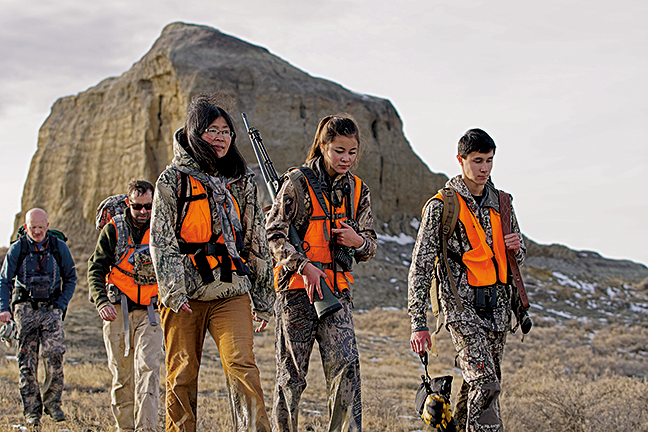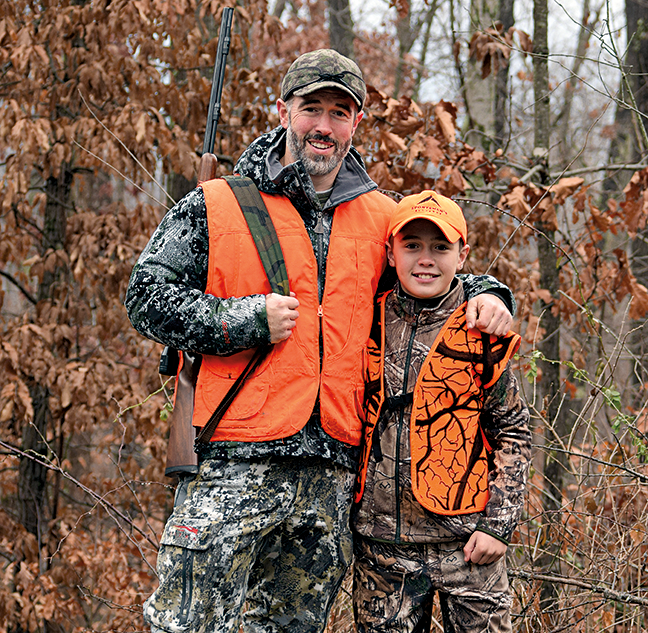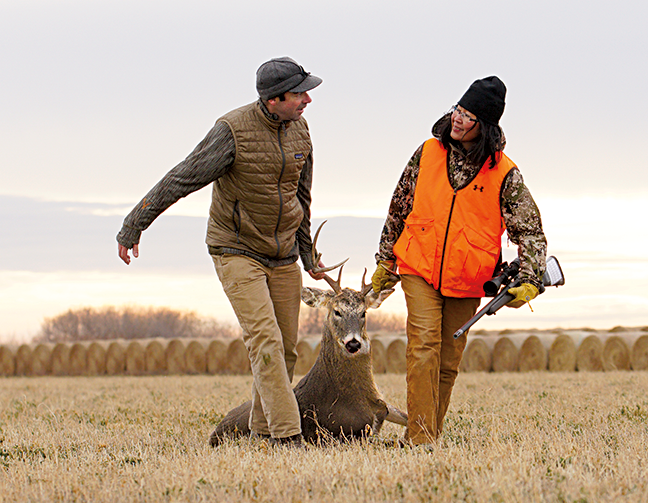WE'VE LOST 2.2 MILLION HUNTERS SINCE 2011. HERE'S HOW TO HELP SAVE HUNTING.

Doug's father gave him the rifle, chambered in .300 Savage, when the pair shared their first deer hunt, back in 1969, just as whitetails were returning to their county in northern Missouri after a century of depletion. Doug has hunted with the rifle a couple of times since, but the Savage has migrated farther back in his gun safe as Doug has added synthetic-stocked bolt guns and semiautomatic rifles to his firearms collection.
These days, there's no shortage of whitetails around Doug's place. In fact, when we hunted together two Novembers ago, we each could have hung our tags on mature bucks within the first hour of the season. What's lacking in Doug's life isn't deer or guns; it's somebody to pass that Savage 99 down to.
Doug's kids don't hunt. His neighbors have leased their farms to out-of-area hunters who don't bring kids when they come twice a year, once for bow season and again for the rifle season in November. The closest Doug, who just turned 60, can get to a gun-worthy heir is his sister's husband, but he's nearly Doug's age and lives a couple states away.
"I've thought about just giving Granddad's rifle to one of my kids in the hopes that maybe they'll have kids who hunt or shoot, but that seems really unlikely," Doug told me. "My kids were raised as hunters and shooters, but I don't think my grandkids will be."
The License Cliff
You may think you encounter too many camo-clad competitors in the places you hunt, whether it's a public duck marsh or a limited-draw elk unit. But the reality is that the number of licensed hunters is down across the country. Hunter numbers peaked in 1982, when around 17 million of us bought licenses. I was a high school sophomore in rural north Missouri that year, and it seemed like every one of my friends — including Doug's cousins — hunted every chance they got. Full disclosure: I killed my second whitetail with Doug's grandfather's Savage, so its fate is personal to me.Since 1982, hunting participation in America has declined steadily. In 2016, the last year for which the U.S. Fish & Wildlife Service has data, only 11.5 million hunters were counted, a drop of 2.2 million from the USFWS's 2011 survey.
Sure, that's still a lot of hunters, and on opening day of deer season, it can seem like most of them are in your county. We're accustomed to demonizing these anonymous competitors for stealing "our" opportunity, but take a closer look at them. Chances are they look a lot like you: middle-aged white guys craving a chance to do what they love to do.
This is the second problem with America's population of hunters. Not only are we getting fewer, but also we're getting older. According to the USFWS, back in 1991 52 percent of U.S. hunters were between the ages of 25 and 44. Demographers consider this the most productive segment of society, comprising members who are disproportionately physically healthy and actively contributing labor and economic benefit to their communities. By 2011, the percentage of hunters in this age bracket had dropped to 33 percent of the whole. The percentage of hunters aged 45 — 64 had climbed to 44 percent. More troubling is the percentage of hunters over age 65 — 11 percent in 2011 (up from 6 percent in 1991). State wildlife agencies figure that most hunters stop buying licenses when they hit about age 70.
If you are silently cheering this trend because you think it will create more opportunities for the rest of us, consider that as both the absolute number and percentage of hunters decline, so do license sales that support wildlife management in America. So do the markets for guns and bows and the habitat-enhancing excise taxes their sale generates. And so do political and cultural support for hunting.
Statisticians call this decline the "license cliff," and the current trajectory shows the slide accelerating and steepening. Factor in another demographic trend — the urbanization and cultural diversification of America — and it's easy to imagine a future in which hunting is considered a quaint curiosity of a bygone era and not a dynamic part of the modern American culture, economy, and landscape.
Recruitment Redux
Demographic trends are a little like battleships. They take a long time to gain momentum, but once they establish direction, it's hard to influence their trajectory. Will we ever again be a country of 16.7 million hunters, as we were in 1982? Probably not. But Eric Dinger is convinced that we can stabilize the slide toward oblivion and even add hunter numbers, if we do one simple thing."We have to replace ourselves," said Dinger, the cofounder and CEO of Powderhook, a digital app that aims to connect hunters and anglers with people who don't currently participate regularly in either activity. Powderhook intends to help create three million new hunters in the next five years, mainly by making it easier for us to talk to each other, help each other, and feel more like companions than competitors.
The idea is that as each of us ages out of hunting we will have recruited someone to take our place, someone who in turn feels both obligated and eager to replace themselves, creating a chain reaction with our hunting heritage as its fuel rod.
"If every one of us took just one person hunting next year that number looks completely different," said Dinger.

In recent years, conservation organizations — most notably the National Wild Turkey Federation, National Shooting Sports Foundation, Sportsmen's Alliance, and the NRA working through the Families Afield initiative — have worked to lower barriers to hunting participation. But many of these efforts have focused on youth and haven't adequately followed up to ensure that activated kids continue to buy licenses and hunt when they become adults.
"That's a key point," said John Frampton, president and CEO of the Council to Advance Hunting and the Shooting Sports and one of the national leaders of the
accelerating R3 movement. R3 stands for Recruitment, Retention, and Reactivation.
"We have to reach out to the population of adults who may have been introduced to hunting earlier in life and have fallen away from it [reactivation] or who have never been introduced to it in the first place [recruitment]. These are people with disposable time and income and who can understand and appreciate that hunting is an activity that can improve their quality of life, provide them with high-quality food, and give them a connection to the natural world."
After years of stop-and-start work aimed at slowing the decline of hunters, this appears to be the year of intentional R3-ing. Commissions are studying the problem. Symposia will discuss solutions. But Dinger says one demonstrated way to fix the slide is to do what hunters do best: talking passionately about hunting.
Digital Mentoring
Don't underestimate the power of connection, even in the relatively anonymous ether of cyberspace. Once hunters start talking to would-be hunters, Dinger says, it's a relatively easy next step to bring the relationship into the real world, one that can blossom on a clays course or in the turkey woods.Prospective hunters need real-time local answers. They don't want to scour the Internet to piece together the answer to a question. And often they want to communicate anonymously. The Powderhook app enables all those dynamics by incentivizing the exchange of information. By participating in this exchange, digital mentors can earn status points that they can trade in on products or reduced prices at retailers.
But Powderhook's main role is as a virtual campfire, a place to foster dialog between those who have information and those who hunger for it. In simpler days, that relationship was called mentoring and apprenticing.

"Those partners are critical to our work and amplifying the message," said Dinger. "One day, when someone says, 'I'd like to learn to hunt,' I'd like the reflexive response to be, 'You gotta get Powderhook.' Not because we're going to do all the work, but because we can empower everyone to do some of the work."
Will my buddy Doug Hinkle download the Powderhook app? When I asked, he was both candid and dubious — two qualities that define most of the hunters I know, especially those from the Show-Me State.
"Do I wish there were more hunters in my world? Yeah, I do. I'm starting to feel like the only guy around who hunts," said Doug. "Am I gonna give my Savage to a guy I meet online? Not likely. But I've got a lot of deer, and I wouldn't mind helping somebody get their first buck. It honestly doesn't sound like that hard a thing to do."
没有评论:
发表评论